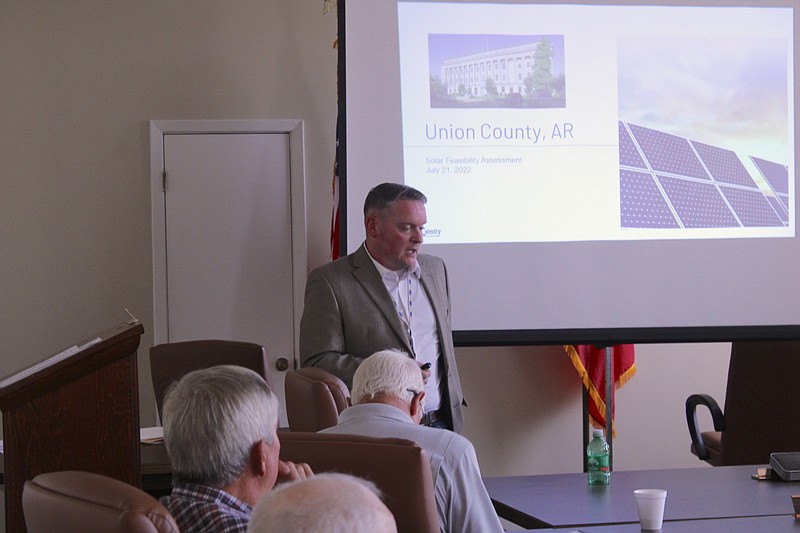Union County may soon be going green.
During last month's Quorum Court meeting, Union County Judge Mike Loftin gave representatives from McKinstry, a national construction and energy services firm, the go-ahead to move on to site testing two potential locations for a solar panel field that would provide energy to county properties.
The proposal
Jay Holstead, an account manager for McKinstry, and his colleagues Walter Wills, a project director, and David Stephen, a project manager, presented a detailed assessment of the cost and benefits of installing a solar panel field to provide energy to the county last month.
Their presentation closed out the meeting, which had already gone on for about an hour, and five Justices of the Peace, along with Loftin, stayed to hear from them.
"We're not a solar company. Yes, that is a big focus, we do lots of renewable energy around the country, but we're energy efficiency -- we work as an energy partner with our clients to help identify waste streams and reduce those so we can improve your budgets," Holstead said. "Today's focus is on the solar... We're in the identify stage -- kind of establishing the baseline, understanding the needs... And then from there we can help develop a plan and move into the next phase, which is where we start to narrow down the focus, the budget, sharpen the pencil so to speak, and come back with a shovel-ready project."
Holstead put forth several options for solar fields the county could invest in at two potential locations – a former landfill on Commerce Drive and a site on Industrial Road on city-owned property maintained by the county.
He noted that because Entergy Arkansas currently offers one-for-one net metering – meaning that kilowatt-hours (kWh) produced by a customer through renewable energy sources and supplied to the local power grid are credited to the customer's account against the kWh they use from the grid at a one-to-one ratio --, the county would likely come out on top if they invested in a solar field.
"The utility company has to provide enough wattage on the grid to support a 100 Watt lightbulb... That's called your demand. The usage is how many hours at that 100 Watts did you consume over a day, over a month, over a year -- kilowatt-hours," Holstead explained. "The utility is essentially buying it and placing it onto their operations, out to the grid, and you're getting a credit for that, so it's like you're banking kilowatt-hours produced versus what you're consuming."
To self-fund a solar field that would produce 299 kWh per year would earn the county $1 million after 20 years, and for a solar field producing 730 kWh per year, the benefit would grow to $1.6 million after 20 years. A debt-financed solar field producing 299 kWh per year, at 3.8% interest, would earn the county $6,148 after 20 years, Holstead said.
The solar panels McKinstry would install, he said, would work on cloudy days, and the products' degradation-over-time was included in the projections presented in the proposal. Annual maintenance would cost about $800 per year, Holstead said, and insurance should cover any damage to the panels.
And McKinstry will put their money where their mouth is, he said.
"We're doing what's called measurement verification -- that's where we come back and verify the system's producing X amount, and if for any reason it's not producing what we said, we write a check for the difference, so this is a guaranteed savings project," Holstead said.
The one-for-one net metering offered by Entergy will end after 2022, Holstead said, so there was a degree of urgency to the proposal.
"That net metering of one-for-one, that ends at the end of this year -- it sunsets. And then it will be anybody's guess what the utility -- they might get away with giving you a quarter of what you've generated, and then, this is not feasible," Holstead said. "This is a really, really good deal. I'm going to be a little biased here -- I think this is one of the best investments you can make, because it's generating money for the county."
Next steps
The next step, which Loftin approved last month, will be to take soil samples at the two potential sites to determine what the cost to install solar fields would ultimately be. Holstead said McKinstry will test the soil at its expense, and will only charge the county if officials choose not to move forward after that.
"It doesn't cost us anything until we walk away at the second phase -- if we walk away at the second phase, it's going to cost us $15,000," Loftin said.
Estimates presented last month listed a capital cost of $701,454 for a solar field that would produce about 299kWh per year and $1,469,125 for a field producing about 730 kWh per year. The former would be paid off in about 14.5 years if self-funded by the county, and the latter in about 18.5 years.
"I want you to test Industrial Road first, and if it's good, then I'll go to the city and say I need to build this out there... I don't see a problem getting it, but let's test it first, and while I'm getting forgiveness or permission to put this thing out there if we do it, we might want to test that other site, a couple of places, just for good measure," said Loftin.
